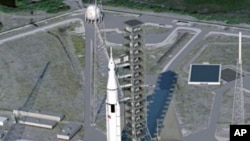NASA on Wednesday unveiled its long-awaited plans for a new, powerful rocket to take astronauts beyond low-Earth orbit to the Moon, to asteroids and, one day, to Mars.
NASA has selected the design of a massive rocket that will take humans beyond low-Earth-orbit into deep space, and the space agency says it hopes to fire up this rocket in late 2017 for an unmanned test mission.
NASA's chief, Charles Bolden, says the agency is ready to move ahead with the Space Launch System or SLS, a rather dry name for what NASA says will be the biggest and most powerful rocket ever built, and that will take people farther into space than ever before.
"The SLS will be the cornerstone of our deep-space human exploration program," said Bolden. "President Obama has challenged us at NASA to be bold and to dream big, and that's exactly what we do. While I was proud to fly on the space shuttle, tomorrow's explorers will dream of one day walking on Mars."
President Barack Obama has set the goal of a manned-mission to an asteroid by 2025 and to Mars the following decade.
The Space Launch System will be NASA's first exploration-class vehicle since the Saturn V, which carried astronauts to the moon more than 40 years ago. But this new rocket will have 10 to 20 percent more thrust than the Saturn V. In more relatable terms, the final version of the SLS would have more than 34 times the total thrust of a 747 jet.
NASA animation:
NASA envisions two versions of the SLS, with the initial version being nearly 100 meters tall and able to carry 70 metric tons - about the weight of 12 adult elephants. The second "evolved" version would be even taller - 122 meters - and able to carry the equivalent of 21 full-grown elephants into space.
The SLS will use a liquid hydrogen and liquid oxygen propulsion system, and the colossal rocket's core is similar to the orange-colored external tank that was used in the space shuttle's launch configuration. It will have five main rocket engines.
The new capsule that will carry the crew, called the Orion Multi-Purpose Crew Vehicle, is being built. The crew module would sit at the top of the launch system. In the event of a launchpad explosion or failure during ascent, the module will have an abort system that would rocket it away from the launch vehicle and carry the astronauts to a safe splash-down.
But, innovation does not come cheap. NASA estimates the program will cost $18 billion over the next six years - and that is just through the unmanned test flight. The cost includes the rocket, capsule, and efforts to reconfigure the launch facilities at the Kennedy Space Center in Florida.
Kay Bailey Hutchison is the ranking member of the Senate Committee on Commerce, Science and Transportation. Speaking alongside other lawmakers and NASA's Bolden Wednesday, she said this plan enjoys bipartisan support in Congress.
"I believe that we will get the funding," she said. "I will just use as an example - even some of the strongest budget cutters on my side of the aisle have put forward massive cuts, but they have not cut the core mission of NASA because they see that as a part of the American spirit and most certainly part of the American economy and America's national security."
The SLS will benefit from the technological strides made in the space shuttle program as well as the now-defunct Constellation program, which was developing a replacement for the shuttle fleet that was retired in July.
Officials say building on other programs will take advantage of hardware that is known to work and will reduce development and operations costs.
NASA says the new launch system design is adaptable, and it will allow engineers to use different core and booster combinations, depending on the mission. Although commercial enterprises have been tasked with developing vehicles to ferry cargo and astronauts to-and-from the International Space Station, NASA says its new deep-space rocket will also serve as a back up.













